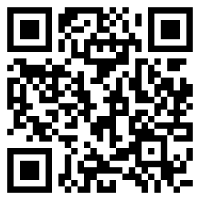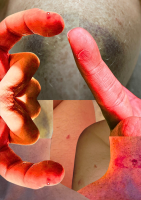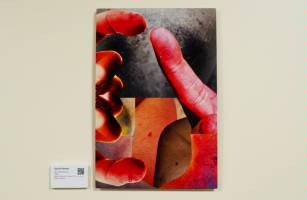‘Wounded Parties’ (2024) by David Fenton
Other
| Title | ‘Wounded Parties’ (2024) by David Fenton |
|---|---|
| Type of Work | Other |
| Creator/Contributor | Fenton, David |
| Year | 2024 |
| Place of Publication | Australia |
| Web Address (URL) | https://www.youtube.com/watch?v=N2tgIIFfbS4 |
| Description of Work | ‘Wounded Parties’ (2024) NTRO Rationale ‘Wounded Parties’ (2024) is a series of photographs of wounds the artist/researcher, David Fenton, has incurred and recorded over since 2023, stitched together to create a digital composition which is accompanied by a QR code of the process of making the work. As such, the work is presented as both artifact and performance – overall the combination of artefact/performance constitutes ontologically the work as a performance. The background of the work stems from a series of works called ‘Field: White-card’ (2023/4), which commenced creation and investigation in late 2023. ‘Field: White-card’ has had three iterations all of which have investigated de-anthropocentric performance. The most recent NTRO was called ‘Field-Canvas’ (2024) and was a transitionary work that started to challenge how the presentation of a traditional artefact could also maintain the ontology of its original intent as a performance. New knowledge that informed the artist’s methodology was the inclusion of a QR code along with the artefact that operated as Bolter (1991, p. 25) describes hypertext as “Electronic writing [which] is…not the writing of a place, but rather a writing with places, spatially realized topic[s]” [original emphasis]. This writing with place leads the viewer into more in-depth performative understandings of the work’s construction and as such alternative meaning through alternative perceptions of the stability of the work. This was applied to the ‘Wounded Parties’ (2024) and the artifact as well as the QR code (leading to the performative process of making the work) were included in the ‘Resilience’ exhibition at St Andrew’s Toowoomba Hospital August 2024. Performance Ontology: New knowledge manifests materially in two ways within the work. It is the first digital collage the artist has attempted/performed. This is a new formal application for the artist who has predominately worked in ‘live’ performance. Here the live performance of the work is mediatized at least three times. Firstly, through its original capture, second through its digital collage manipulation and third through the QR code conveying the performance of the whole process. As such, this has become an interdisciplinary foray into a deeper understanding of intermedia for the artist. The work troubles the field by troubling the ontological status of the artifact, destabilizing the primacy of its reception as a static object and reconceiving the work as a work ‘in a performative process’. It contributes as it were to a significant debate concerning the ontology of the still image. For example, in Derrida’s notion of hauntology he expresses the ontology of the photographic image as an operation of metonym, a substitution, for what was or what may have been. Derrida proposes that the ‘living present divides itself’ ( Derrida and Stiegler, 2002; 51). The photographic referent has no ‘presence’ of itself after itself, but rather exists as an ontological paradox, a process of disappearing and becoming. In this way a work that has been mediatized three times plays with the notion of presence, plays with the ontology of performance through multiple ‘re-mediations’ (see Bolton and Grusin 2000) and as such, a multiplicity of readings and experiences become available to the percipients – those who ‘perceive’ the work. Monstrous Post-humanism: With regards to content the work is akin to live art, often informed by the monstrous feminine. Here, however the work examines the wounded masculinity of the artist. Deconstructing, repeating, and reframing that masculinity through a queer theory lens. As such, the work can be seen as both body parts (fingers) but also genitalia. This would seem an inevitable consequence of ‘Filed: white-card’ that endeavored to destabilise the body’s primacy of performance so that (through a new materialist imperative) the body operated as an equal inter-actant in the assemblage. Instead, here in ‘Wounded Parties’ (2024) the artist/research has placed the body central with primary status. Here the masculine wounded body is not denied or reduced to mere material but forms the entire landscape of the material of the work. This is a breakthrough into a new form of expression for the artist, where before the body was interacting with other material objects, in an endeavor to reduce its primacy (i.e. de-anthropocentric performance) here the body in the digital intermedial form can only interact with itself, forming reconfigurations impossible to form through live performance. The work contributes to its field in as much as the content continues a conversation concerning the necessity to reframe the masculine through feminist notions of the body in performance. It is also significant as it is an affirmation of post-human positioning of the male body (wounded, incomplete and provisional) in response to itself i.e. intar-subjectively. Here there are other practitioners in the field who have performed in this monstrous and queer territory and indeed have had their performance re-mediated from the live to the mediatised. For example Paul McCarthy’s early Live Art works, which trouble the ongoing concerns of what is permissible, between live acts and the audience. Additionally, the performance oeuvre of other artist’s work such as Hermann Nitsch, Franco B, Ron Athey, Karen Finley and Holly Hughes, in the 21st century still remain transgressive and shocking. They trouble the boundaries of the body as it performs itself, with its own fluids, food and other substances. References: • Creed, B. (2015). The Monstrous-Feminine (0 ed.). Routledge. https://doi.org/10.4324/9780203820513 • Process art. (n.d.). Wayback Machine Internet Archive. Retrieved September 17, 2024, from http://www.guggenheimcollection.org/site/glossary_Process_art.html |
| Keywords | St Andrew's Hospital; Intermedial Performance; Process Art; Autoethnographic; Interdisciplinary |
| Contains Sensitive Content | Does not contain sensitive content |
| ANZSRC Field of Research 2020 | 360603. Performance art |
| 360499. Performing arts not elsewhere classified | |
| Public Notes | File reproduced in accordance with the copyright policy of the publisher/author/creator. |
| Byline Affiliations | School of Creative Arts |
| St Andrew's Toowoomba Hospital, Australia |
https://research.usq.edu.au/item/z8yx6/-wounded-parties-2024-by-david-fenton
Download files
Work
| adobe-express-qr-code (1).png | ||
| Wounded Parties 2024.png | ||
| File access level: Anyone | ||
Recording of the Work
 | ‘Wounded Parties’ by David Fenton (2024)).mp4 | |
| Resilience 6.jpg | ||
| File access level: Anyone | ||
78
total views79
total downloads0
views this month0
downloads this month
Export as
Related outputs
Congratulations, Get Rich! is a Glittering Ghost Story Where Emotion is Lost to Theatrics
Cantrell, Kate and Fenton, David Raymond. 2025. "Congratulations, Get Rich! is a Glittering Ghost Story Where Emotion is Lost to Theatrics." The Conversation. https://doi.org/10.64628/AA.vth7ncvr9
Cold Whitman [Previous Owner]
Fenton, David. 2025. Cold Whitman [Previous Owner]. University of Southern Queensland.Dramaturgical Practice: 'My Two Blankets" Creative Development 1 & 2
Fenton, D.. 2024. Dramaturgical Practice: 'My Two Blankets" Creative Development 1 & 2. University of Southern Queensland 24 - 28 Jun 2024
'Field' (White-card) 2
Fenton, David. 2024. 'Field' (White-card) 2. Melbourne, Australia 12 Mar - 13 Apr 2024


